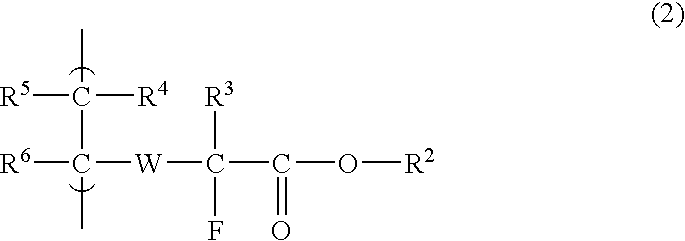Fluorine-containing compound, fluorine-containing polymer, postive-type resist composition, and patterning process using same
a technology of fluorine-containing polymers and patterning processes, applied in the direction of photosensitive materials, bulk chemical production, instruments, etc., can solve the problems of difficult to obtain patterns as originally designed, inability to use novolac resins and polyvinyl phenol resins, etc., and achieve the effect of superior rectangularity
- Summary
- Abstract
- Description
- Claims
- Application Information
AI Technical Summary
Benefits of technology
Problems solved by technology
Method used
Image
Examples
example 1
Synthesis of ethyl 2,2-difluoro-3-hydroxy pentanoate Represented by the Following Formula
[0182]
[0183]A 500 mL reactor was charged with 24.2 g (370 mmol, 1.3 eq) of activated metallic zinc and 300 mL of tetrahydrofuran (THF) (dehydrated one), followed by adding in a dropwise manner an ethyl bromo-difluoro acetate / THF solution prepared by adding 51.47 g (253.6 mmol, 1.0 eq) of ethyl bromo-difluoro acetate to 80 mL of THF (dehydrated one). After the dropping, stirring was conducted at room temperature for 20 minutes, followed by adding a propionaldehyde / THF solution prepared by adding 14.80 g (254.8 mmol, 1.0 eq) of propionaldehyde to 80 mL of THF (dehydrated one), and then stirring at room temperature for 30 minutes. Then, water and diisopropyl ether were added, followed by separation of an organic layer from an aqueous layer. The obtained organic layer was washed with diluted hydrochloric acid and water, followed by removing water with magnesium sulfate, filtration, and distilling th...
example 2
Production of 1-ethoxycarbonyl-1,1-difluoro-2-butyl methacrylate Represented by the Following Formula
[0187]
[0188]A 25 ml reactor was charged with 1.50 g (8.2 mmol) of ethyl 2,2-difluoro-3-hydroxypentanoate, 6.5 g of chloroform, 10 mg of an antioxidant NONFLEX MBP made by Seiko Chemical Co., Ltd., 1.03 g (9.9 mmol, 1.2 eq) of methacrylic chloride, and 1.25 g (12.4 mmol, 1.5 eq) of triethylamine, followed by stirring at 55° C. for 4 hours. Then, 10 g of water was added, followed by extraction with chloroform one time. The obtained organic layer was washed with diluted hydrochloric acid and water, followed by removing water with magnesium sulfate. After conducting filtration, chloroform was distilled off, thereby obtaining 2.06 g of the target 1-ethoxycarbonyl-1,1-difluoro-2-butyl methacrylate. Purity was 66%, and yield was 66%.
[0189]The property of 1-ethoxycarbonyl-1,1-difluoro-2-butyl methacrylate was as follows.
[0190]1H NMR (CDCl3) d 6.14 (s, 1H; methylene), 5.62 (s, 1H; methylene),...
example 3
Production of 1-hydroxycarbonyl-1,1-difluoro-2-butyl methacrylate, methacrylic acid (1), Represented by the Following Formula
[0192]
[0193]A 25 mL reactor was charged with 1.00 g (2.6 mmol) of 1-ethoxycarbonyl-1,1-difluoro-2-butyl methacrylate (purity: 66%) and 1.00 g of water, followed by cooling to 0° C., adding 1.06 g (4.0 mmol, 1.5 eq) of 15 wt % sodium hydroxide aqueous solution in a dropwise manner, and then stirring at room temperature for 1 hr. The reaction solution was washed with 10 g of diisopropyl ether. The obtained aqueous layer was washed with diluted hydrochloric acid, followed by extraction with diisopropyl ether two times, removal of water with magnesium sulfate, filtration, and then distilling diisopropyl ether off, thereby obtaining 0.19 g of the target methacrylic acid (1). Upon this, purity was 78%, and yield was 27%.
[0194]The property of methacrylic acid (1) was as follows.
[0195]1H NMR (CDCl3) d 7.24 (br, 1H; COOH), 6.16 (s, 1H; methylene), 5.63 (s, 1H; methylen...
PUM
| Property | Measurement | Unit |
|---|---|---|
| wavelength | aaaaa | aaaaa |
| width | aaaaa | aaaaa |
| carbon number | aaaaa | aaaaa |
Abstract
Description
Claims
Application Information
 Login to View More
Login to View More - R&D
- Intellectual Property
- Life Sciences
- Materials
- Tech Scout
- Unparalleled Data Quality
- Higher Quality Content
- 60% Fewer Hallucinations
Browse by: Latest US Patents, China's latest patents, Technical Efficacy Thesaurus, Application Domain, Technology Topic, Popular Technical Reports.
© 2025 PatSnap. All rights reserved.Legal|Privacy policy|Modern Slavery Act Transparency Statement|Sitemap|About US| Contact US: help@patsnap.com



